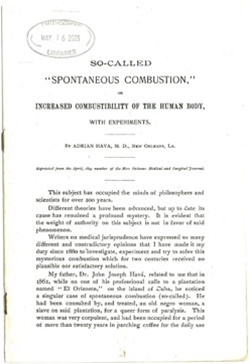So-Called Spontaneous Combustion
So called spontaneous combustion : or increased combustibility of the human body, with experiments
Spontaneous human combustion describes the burning of a living human body without an external source of ignition. There is speculation and controversy regarding this phenomena. Some regard it as unique and unexplained, while others feel that cases described as spontaneous human combustion can be understood using generally-accepted scientific principles. In this publication, an undated reprint originally published in The New Orleans medical and surgical journal in April 1894, Dr. Adrian Havá researched the possible causes of spontaneous combustion based on an incident observed by his father in Havana, Cuba in 1862. Havá, a medical doctor like his father, emigrated from Cuba to New Orleans in 1869 when he was just nine years old. He was a beloved servant in his community who was known for heroically administering to the poor at the peak of the 1918 flu epidemic. Other papers he authored are on the 1918 influenza epidemic, carbon monoxide poisoning, and yellow fever. Our copy of So called “spontaneous combustion,” or increased combustibility of the human body, with experiments was dedicated to the memory of his father, John Joseph Havá, is a signed complimentary copy from the author, and is property stamped by Dr. Wm N. Greene.
A late 19th century pamphlet housed in an acidic enclosure. The pamphlet cover is adhered to the gutter of the acidic enclosure at the gutter and has a 10cm long tear down the left hand side. The pamphlet is staple bound and the staples have oxidized. Conservators will remove the pamphlet from the acidic binding and remove the rusted staples. The wrapper will be repaired and the pamphlet re-sewn and housed in a new acid-free case.
Discover more about this book in our Catalog.
Adoption Type: Preserve for the Future

